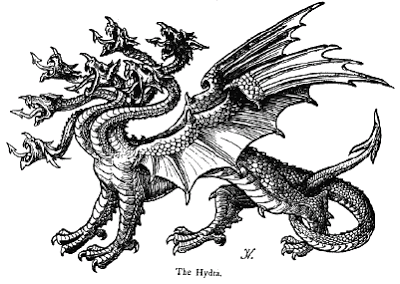SEVEN-HEADED SERPENT: GUARDIAN OF THE ORINOCO


They are legends, myths or fables that have been told to us since we were children, at the time to frighten us when we were behaving badly, when we were not doing our homework, or simply to make cases for our parents. I think we've all grown up with the legend of the Coco.
Phrases like "if you don't eat the vegetables, I'll call the coconut to take you"... "if you don't go to school, the coconut will take you" and stop counting, these kinds of expressions terrify us as children.

Certain or not, legends are part of the essence of each country, it is those that differentiate us from other regions, many tend to resemble the few in other territories, but each country gives its own identity.
Venezuela is one of those countries that does not escape superstitions, from the center to the Venezuelan south they captivate us with diverse histories, that can be interesting and even become somewhat terrifying.
The State of Bolivar is located in a jungle area called the Guayana region, which includes the states of Bolivar, Amazonas and Delta Amacuro. Its streets were the scene of great battles, so it has a high cultural level, a lot of history and magic in every corner.
Being its capital Ciudad Bolívar, the attraction is the Mirador Angostura and its river Orinoco, being the largest and most important river in Venezuela with an extension of 2140 km, and width of 5 km, is the third largest in the world, behind the Amazon and Congo.

Orinoco is a word in the WARAO language (which are the indigenous people of the region) that means "place to row" or "place to row". In this river, there is a rock formation millions of years old, 350 meters long, 100 meters wide and 52 meters high, which is called the Middle Stone and has been the gauge of river flows and the locals know it as the Orinocómetro. Being the protagonist of the legend of the seven-headed serpent, you may wonder: seven-headed serpent? And yes, just as in Greek mythology known as the Hydra.
Superstition is part of the Venezuelan idiosyncrasy, and this originates from our indigenous ancestors. Years ago, in 1700, the Indians realized that the area of the stone had certain eddies, and ebb and flow movements believed that there was an "imposing beast" that caused these movements in that area.

This legend was boosted by certain events that took place there, such as the disappearance of vehicles that fell from the bridge over the Orinoco, but it was an event that triggered the superstition of the locality.
One day, a river boat loaded with vehicles was being transported along the river, and it collapsed in the area near the stone, and no remains of the boat or the vehicles it was transporting could be found. This situation originated some oceanographic studies research promoted by the Universidad Nacional de Oriente (UDO) to determine the reason for the sinking, fate of the ship, crew and vehicles. They brought three expert divers, who ventured to dive in the river, it is said that they descended and of the three, one of them ascended with a nervous breakdown exclaiming that he had seen an animal with a very large eye similar to a cassava cake.
With the expedition it was determined that in front of the stone there is a 160 m deep pit, which looks like a cone or funnel and is what causes the large eddies in that area. What is certain is that it is the habitat of this great mythological animal, so everything that disappears or sinks around the Middle Stone goes to the snake.
What left the community with more uncertainty, because of what happened because, just in that area when the river grows, many boats have been lost, without leaving any trace, people have disappeared and the same fishermen have reported hearing strange noises near the stone.

The legend indicates that the main head is located in the same stone (1), and the rest are located in Laguna Los Francos (2), Laguna el Porvenir (3), in the Metropolitan Cathedral (4), Isla Panadero (5), Isla el Degredo (6), and finally in Casa San Isidro (7). The Bolivarian community emphasizes that this great animal shelters the city, the reason when it moves is because it is thirsty, they also mention that this beast is in a deep sleep and when it wakes up the city will sink.
It is curious that this story resembles the one told in Greek mythology. The seven-headed serpent known as the Hydra, which relates the presence of an animal that inhabits and protects the underwater entrances to the underworlds.

In the late 80's it was the last report of having seen this animal. It was night and the Bolivarians heard noises near the river, so they ventured to approach with flashlights and torches managed to observe shadows of a large snake.
It is undeniable that the sunsets of the Orinoco River are an absolute beauty, but if you focus your attention more on its waters, you will experience sensations of attraction and charm, which happen in a matter of seconds it is as if the same river will captivate you and invite you to know it, and it has happened to hundreds of people who have heard a voice calling them to enter the river.

It is no lie to anyone that the Orinoco River has a particular charm, and is home to mythological beings.

I don't know if the story is real, or just another legend, as many are told about this river, but when I watch the sunset over its waters, I feel the mysticism they contain and it gives me a certain enigma, knowing that secrets hide its waters.
